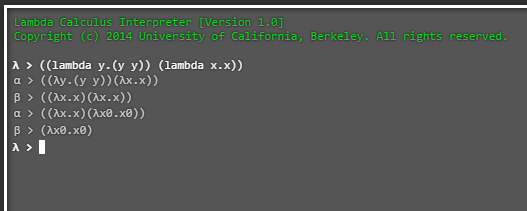Friday April 14th
4/14/17 - Lambda Calculators <=> to the Moon and Back
Today I learned:
- Rewatched Dustin Mulcahey’s talk on “Lambda Calculus” from LispNYC group. Also found a neat online Lambda Calculator, but I have to learn the syntax :) —> lambda calculator
Beta-Reduction

Today I learned…cont’d:
-
Watched a great documentary on Titan and Cassini, and some on Vesper. Learned about cryo-volcanoes. I guess this is what happens when you hang out with rocket scientists the evening before. :)
-
Learned about Porkchop plots, Delta-v, the Oberth Effect and the Tsiolkovsky rocket equation for calculating orbital maneuver.
-
Manacher’s Algorithm -> Palindrome substrings
Random Kata:
- If you fold a piece of paper that has a thickness of .0001m, calculate how many times you have to fold the paper to make the paper reach the distance of the Earth to the moon.
function foldTo(distance) {
var t = .0001; // thickness of paper
var a = distance / t // total length -> distance / thickness => 3840000000000
// check to make sure length or distance is a number above 0
if (distance <= 0){
return null
}
else{
// find the value where 2^n is less than total length, a
for (var i = 1; i < a; i++){
if (Math.pow(2, i) > a){
var a = i;
}
}
}
return parseInt(a) // returns 42
}
Things to get done:
-
C++ quiz will get done, and hopefully posting to C++ discussion board.
-
Equivalence lecture and quiz.
Notes on Equivalence:
Let E1, E2 and E3 be any predicates whatsoever.
Commutativity
-
conjunction: (E1 AND E2) <=> (E2 AND E1). This is self-evident.
-
disjunction: (E1 OR E2) <=> (E2 OR E1). This is self-evident.
-
equivalence: (E1 <=> E2) <=> (E2 <=> E1). This is self-evident.
Associativity
In associativity, grouping is not important, so we can ignore the parentheses.
-
conjunction: E1 AND (E2 AND E3) <=> (E1 AND E2) AND E3. This is self-evident.
-
disjunction: E1 OR (E2 OR E3) <=> (E1 OR E2) OR E3. This is self-evident.
Distributivity
-
E1 AND (E2 OR E3) <=> (E1 AND E2) OR (E1 AND E3). This is like separating the two via factorization. so x AND (a OR b) —> xa OR xb
-
E1 OR (E2 AND E3) <=> (E1 OR E2) AND (E1 OR E3). so x OR (a AND b) —> (x or a) AND (x or b)
De Morgan’s Laws (note the flipped signs upon expansion)
- NOT (E1 AND E2) <=> (NOT E1 OR NOT E2). Expansion. —> !(x AND y) == (not x OR not y)
- NOT (E1 OR E2) <=> (NOT E1 AND NOT E2). Expansion. —> !(x OR y) == (not x AND not y)
Negation:
- NOT (NOT E1) <=> E1 (!(!x))
Excluded Middle:
- E1 OR (NOT E1) <=> T
Contradiction:
- E1 AND (NOT E1) <=> F (cannot equate to True)
Implication:
- E1 => E2 <=> (NOT E1) OR E2. **This is still a bit un-intuitive to me. **
Equivalence:
- (E1 <=> E2) <=> (E1 <=> E2) AND (E2 => E1) ( if x == x1 then x1 == x and vice versa)
OR-simplification:
- E1 OR E1 <=> E1
- E1 OR T <=> T
- E1 OR F <=> E1
- E1 OR (E1 AND E2) <=> E1
AND Simplification:
- E1 AND E1 <=> E1
- E1 AND T <=> E1
- E1 AND F <=> F
- E1 AND (E1 OR E2) <=> E1
Identity: (very useful knowledge for Monadic Transformations)
- E1 <=> E1
Simplification:
- (E1 => E1) <=> T
- (F => E1) <=> T
- (E1 => T) <=> T
Contrapositive (useful method of proof-solving. Learned this in Devlin’s class! :)
- (E1 => E2) <=> (NOT E2 => NOT E1)
Bugs
Markdown is convenient, but I don’t really care for it that much. In my humble opinion, it isn’t as elegant as LaTeX, which is like a beautiful dream. So intuitive and satisfying to use.
